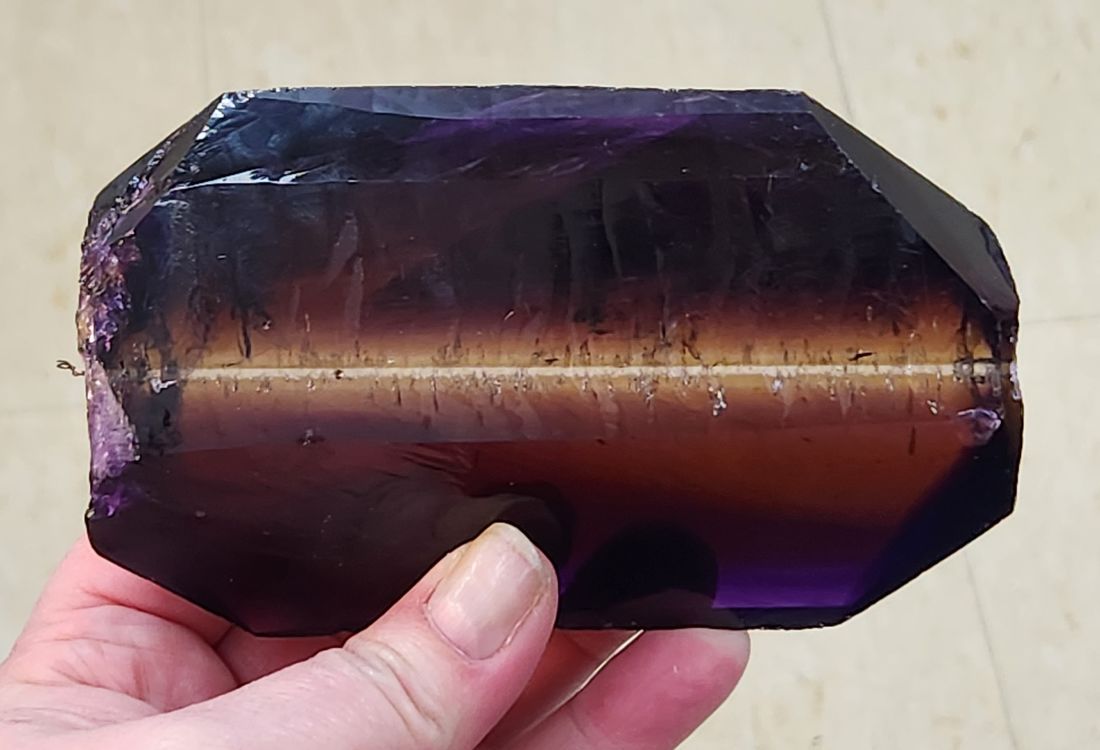The Victorian Division of the GAA (Gemological Association of Australia) has recently added to its collection a large (500gram) piece of synthetic Ametrine.
The commercial production of Synthetic Ametrine has been in operation since the mid-1990s. By 1999, it had become readily available and was subject to an article published by Vladimir S. Balitsky et al., titled "Russian Synthetic Ametrine," which appeared in GIA's Summer 1999 edition. During this period, a Russian factory managed to produce up to 300kg per batch with sales primarily conducted within domestic markets. As evidence of our continued commitment toward enhancing our collection through relevant acquisitions, we have recently added a new crystal specimen that now graces our gemmology lab alongside a slice of synthetic ametrine acquired last year (2018).
The entirety of synthetic Quartz production is achieved through hydrothermal methods. These procedures involve the growth and cultivation of crystals in concentrated alkaline solutions (K2CO3). The process requires exacting conditions, including temperatures that range between 330 to 370 degrees Celsius, as well as atmospheric pressures within the region of roughly 1,200 to 1,500 atmospheres. Such development transpires inside autoclaves with volumes recorded at around or ranging from a thousand to fifteen hundred litres distinctly for this purpose.
The input material comprises pulverized Quartz that may originate from natural or synthetic sources.
The crystal is cultivated on a synthetic colourless Quartz seed plate, which has been meticulously prepared to foster optimal growth of the crystal. Predominantly within commercial production settings, rectangular seed crystals are utilized and precisely cut parallel to the basal pinacoid; these specimens measuring up to 300mm in length by 50mm width with a maximum thickness of only two millimeters. Attributable trait characteristics demonstrate that the aforementioned specimen will grow at an equitable rate ranging from approximately 0.8 –1.0 mm daily along its distinctive surface via the basal pinacoid growth matrix protocol mechanism.
For Info:
Natural Ametrine (Quartz - Silicate Oxide) is a naturally occurring creation of amethyst (purple) and citrine (yellow). The significant location for Natural Ametrine is Bolivia, South America.
An interesting point worth noting:
The synthetic Ametrine crystals are cultivated in a yellow or colorless hue.
The specimens are exposed to cobalt-60 gamma-ray radiation, resulting in the purpling of previously colourless growth sectors while leaving yellow growth sectors unaffected. Following irradiation, the crystals shall undergo a heat treatment for a duration of one hour at 330-350 degrees Celsius to attenuate the intensity of their yellow hue.
Accurately discerning synthetic quartz from its natural counterpart can be a challenging prospect, unless the specimen exhibits an uncharacteristic hue. Furthermore, it is frequently lacking in any visible particulates or other distinctive traits that would facilitate differentiation.
The intriguing aspect of Quartz lies in its twinning phenomenon that produces splendid patterns visible under polarised light - a characteristic enabling Gemmologists to determine its provenance.
Credit: Laura Brehaut - Curator of the GAA (Vic) Gemstone Collection
